Nearly every Grand Cru in Alsace relays a multi-layered story of upheaval — of colliding and grinding geologic forces, of abandonment in the face of economic depressions, and of World Wars and the battles that ravaged the land and its people. But even by Alsatian standards, the Grand Cru Rangen de Thann tells a particularly compelling tale of turmoil.
Volcanic forces forged this inconspicuous hillside adjacent to the town of Thann, making it a geological anomaly in the Vosges Mountains. The Thur River has slowly been scouring the base of its slope, and in October, it provides the blanket of fog needed to develop noble rot in the grape clusters that remain. These two ingredients combine to create some of the most fascinating white wines in the world, particularly those from Domaine Zind-Humbrecht’s monopole, Clos Saint Urbain.
Yet, as recently as the early 1970s, “the Rangen,” as it is often called, lay abandoned — its steeply pitched face ravaged by weeds, shrubs and feral vines, and its compacted soil concealing something far more sinister.
“When we took over the vineyard in the late 1970s, we found roughly a hundred hand grenades that were unexploded.”
Olivier Humbrecht MW
Winemaker, Domaine Zind-Humbrecht
“When we took over the vineyard in the late 1970s,” recounted winemaker Olivier Humbrecht MW, “we found roughly a hundred hand grenades that were unexploded.” Then, in the late 1990s when they halted the application of herbicides and started plowing, Humbrecht and his team made another chilling discovery: three unexploded ordnance from World War II. Likely dropped by aircraft, the huge bombs had been hiding in the dirt for 50 years with no one noticing. Needless to say, they called the French Army to clear them.
But despite the dangers, the father-son duo of Léonard and Olivier Humbrecht could not turn away from Alsace’s southernmost Grand Cru — a vineyard which, despite its sanctioned status, had barely any wine on the market at the time. Their tireless efforts at restoration gave rise to one of Alsace’s most prized wines, the Clos Saint Urbain Pinot Gris.
“Quite simply, it is the best Pinot Gris in the world,” claims award-winning author Ian d’Agata, who is currently working on a book about Alsatian wines. “In fact, it is one of the world’s greatest white wines.”
After their 1978 vintage debut, Zind-Humbrecht’s Clos Saint Urbain wines from the Grand Cru Rangen de Thann made an immediate impact with the French wine press. Inspired by Zind-Humbrecht’s success (as well as the historic appeal of the Rangen), another Alsatian family would join them in 1986 — Domaine Schoffit, who acquired the Clos Saint-Théobald to the east.
The Rangen matters because it refuses to be domesticated. Its relatively high elevation, volcanic soil, steep pitch and proximity to the Thur River combine to make every vintage fickle for the winemaker and beguiling for the wine taster.
History of the Grand Cru Rangen de Thann
When I began my interview with Olivier Humbrecht, I asked him a straightforward, nuts-and-bolts question: when did his family acquire their vines in the Rangen?
He paused, then began: “Let’s go back to the 12th century…”
It struck me as such an Alsatian way to answer the question, because nothing in terms of ownership of vines is easily, or quickly, explained. Naturally, he had to start at the very beginning just to illustrate why his father took such an interest in the Rangen in the 1970s, when Zind-Humbrecht ultimately acquired their prized plot.
But Humbrecht was the perfect person for such a history lesson. As the first person in France to achieve the Master of Wine title — a rarity among winemakers — he has become known for his fastidiousness and curious nature. When I first met him at the Millesimes d’Alsace in 2018, he provided a thorough tutorial on what chilling the must achieves as he casually poured his Clos Windsbuhl Riesling, likening the yeast strands to “viking babies” that have to be “dunked in the ice cold waters to see which one’s survive.” I’m paraphrasing, but the trade-floor tutorial was unlike anything I’d heard before. Olivier Humbrecht operates on another level.
Curiosity and inquisitiveness are familial traits. His father, Léonard, was taken with the Rangen because of its local lore. Franciscan monks were the first to document their cultivation of the esteemed hillside in the 12th century. As the legend goes, a Bishop was traveling through the region, and when he stopped in the valley to camp for the night, he sunk a stake into the ground. When the stake was removed the next morning, water poured forth from the soil. The miracle created a pilgrimage site as well as a need for sacramental wine. With its southern exposure, the Rangen — which may have already been planted with vines — became the monastery vineyard, and soon, gained a reputation all its own.
For the next few centuries, wines from the steeply-pitched hillside at the southern end of the Vosges Mountains would captivate royalty across Europe. Its proximity to Strasbourg and the Rhine River ensured that its wines could travel far and wide. Louis XIV claimed ownership of it for a time in the 17th century, and later, it was the wine poured in the halls of power of the Habsburg Empire in Vienna (Empress Maria Theresa had a particular fondness for the Rangen). Olivier noted that there are even records of the Rangen’s wines being sold to the Russian Empire.
“People raved about it over a very, very long period. When that happens, you go beyond fashion. You go beyond what people drink in a specific moment. That is what drove my father to certain vineyards, especially this one.”
Olivier Humbrecht MW
But even its royal esteem could not save it from the ravages of the 20th century. Weakened by the phylloxera plague, the Rangen was deprived of workers in the 1920s by the booming Alsatian textile industry. Then, successive World Wars made Alsace a key battleground between Germany and France. What followed was a post-war demand for rapid industrialization and rebuilding, which shifted the battered wine industry of Alsace toward mechanization and mass production. Vineyards on the valley floor became the prized real estate. The Rangen was simply too steep to serve the needs of the economy.
“The name of the vineyard is so often mentioned in books, and people raved about it over a very, very long period,” said Humbrecht. “When that happens, you go beyond fashion. You go beyond what people drink in a specific moment. That is what drove my father to certain vineyards, especially this one.”
The Grand Cru Rangen de Thann: Who’s Who
The following map was drawn by Olivier Humbrecht and initially recreated by the French magazine, Le Rouge et Le Blanc. It has been recreated in Google Maps with permission, and can help you as you navigate this article.
The Clos Saint Urbain
Olivier Humbrecht represents a family line of winegrowers that dates back to the Thirty Years War in 1620. But until his father, Léonard, established Domaine Zind-Humbrecht in 1959 (after his marriage to Geneviève Zind of another winegrowing family), much of this activity took place in and around Gueberschwihr in Central Alsace, some 30 kilometers north of the Rangen.
“My father was what you call a ‘soil collector,'” noted Humbrecht. “He would buy the land and then he’d try to figure out a way to make the wine.” This proved to be an exceedingly difficult challenge when it came to reviving the Rangen. Only three of its original 500 hectares remained as vineyard. (For scale, the Grand Cru today is around 20 hectares). Shrubs, trees and invasive plants had reclaimed vast stretches of the Rangen, their roots breaking apart the walls that held the hillside in place.
Only two growers were tending to it at the time: one was a weinstube owner in Thann; the other, an erudite professor based in Strasbourg who, like Léonard Humbrecht, had been captivated by the Rangen’s history. Despite planting very good vine material, the professor’s endeavor was pure fancy — there was no way to practice viticulture from two-and-a-half hours away, let alone on such demanding terrain.
In 1977, the professor’s plot became the first block in Domaine Zind-Humbrecht’s restoration project of the Clos Saint Urbain. Everything about the Clos Saint Urbain was (and continues to be) demanding. The plot surrounds the ancient chapel, stretching from the forest at the top of the hill down to the edges of the Thur River. Unlike most clos vineyards in France, this one has multiple walls throughout it. To fully enclose the vineyard on two of its sides would be impossible and impractical — instead, dry-stone terraces hold the hillside in place to slow the persistent forces of erosion.
“It’s a pretty unique place, and unbelievably steep,” wine writer Ian d’Agata told me. I wanted to know what his impressions were — not only as a noted wine critic who had tasted multiple vintages of Rangen wines and seen their evolution — but as fan of Alsace the region.
“Anytime you’re in the midst of a unique vineyard that makes truly world-class wines … it becomes a special moment where it’s just you, nature and one particularly magical spot.”
Ian d’Agata
Wine writer
“Anytime you’re in the midst of a unique vineyard that makes truly world-class wines … it becomes a special moment where it’s just you, nature and one particularly magical spot,” he told me. “It is hard to explain but they are peace-inducing moments that you just don’t forget. It’s the same with the Rangen.”
The vineyard’s soil leaves a mysterious thumbprint on any of the wines that come from it. Known as greywacke (pronounced GRAH-wock), the ancient volcanic material is suffused with particles of sandstone, and is poor in organic matter. Everything transmitted to the vines is different than, for instance, granite or limestone, and to a taster, the most immediate impression comes in the form of ashy aromas and electric sensation of minerals on the palate. Add to this the Thur River’s humid kiss — and the botrytis that often forms, particularly on Pinot Gris — and you have wines unlike any in the world.
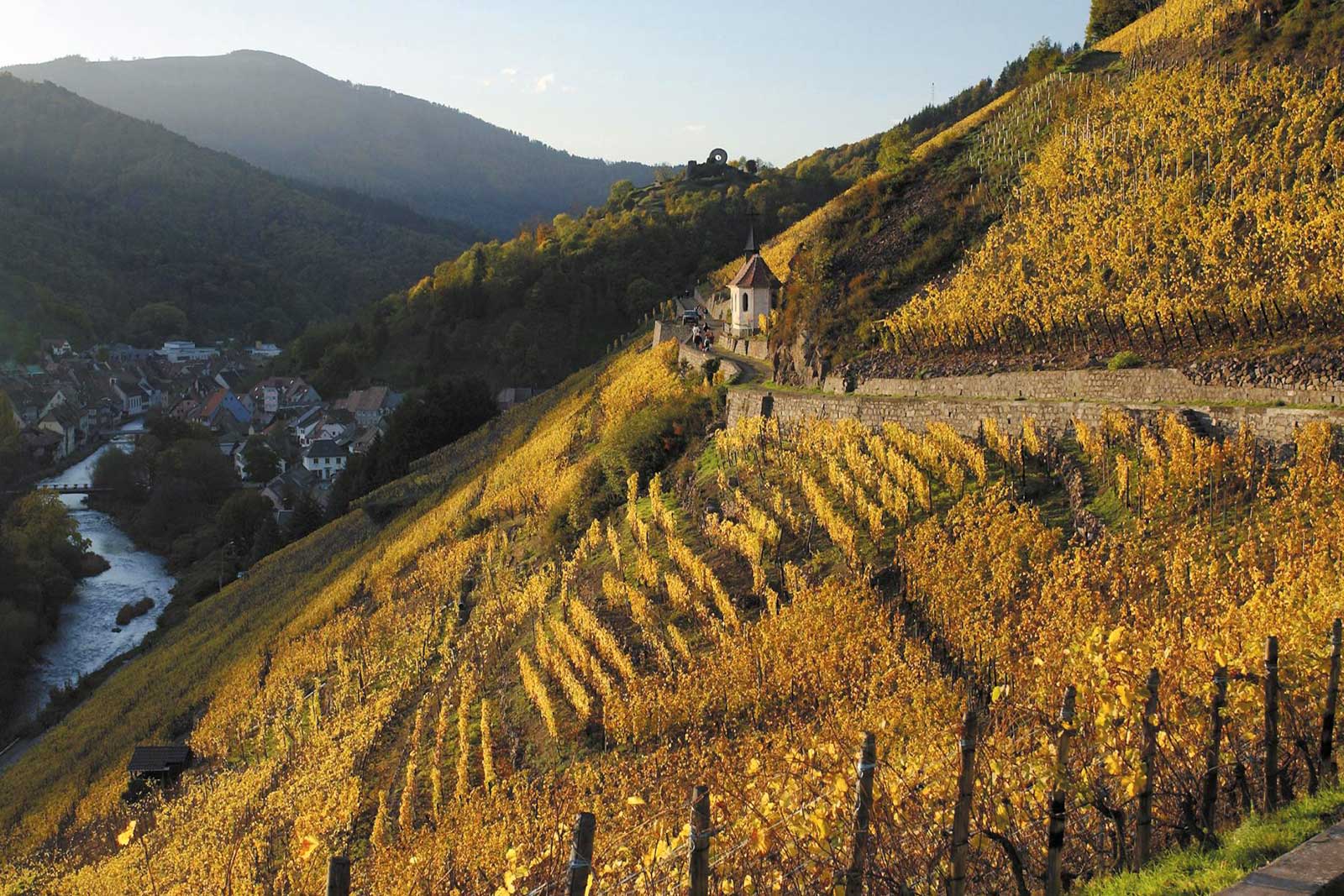
When La Revue du vin de France reviewed the first vintage of Domaine Zind-Humbrecht’s Grand Cru Rangen de Thann Riesling (the 1978 vintage) alongside nearly 50 other Alsatian wines, writer Michel Bettane refused to rank it. “He said he could not include it because exactly half of the tasters on the panel listed it as No. 1, and the other half put it last,” recalls Humbrecht. “To list it as No. 25 out of 50 or something — it would make no sense. It was such a distortion.”
“You have to wait a very long time for botrytis in Riesling. [But] Pinot Gris will look at the fog, and turn into botrytis.”
Olivier Humbrecht
But it would be the Pinot Gris from Clos Saint Urbain that would become the star of the Grand Cru Rangen de Thann. In fact, only in Zind-Humbrecht’s Clos Saint Urbain does Pinot Gris break free of its second-tier reputation as a grape and enter the conversation among “world’s greatest white wines,” as d’Agata calls it. Part of this stems from the wine’s apricot-and-honeyed tones mingling with a tinge of smoke, but its lightning-bolt energy, structure and stability give the Clos Saint Urbain Pinot Gris to seemingly limitless aging potential. The domaine’s Riesling and Gewurztraminer — while less influenced by botrytis — also have tremendous endurance.
Ian d’Agata has tasted through most of the vintages of Domaine Zind-Humbrecht’s Grand Cru Rangen de Thann wines, especially the Pinot Gris, and he notes that — while every vintage is wildly different — they evolve very slowly.
“I personally think the wines don’t change as much over the years as is common with other wines from other [Alsatian] Grand Cru sites — or with most white wines in general.” He suspects that much of this has to do with their concentration, extract level and high acidity. “They tend to remain powerful, broad and saline.”
New York City-based French chef André Soltner — whose Lutèce was the paragon of French cuisine in Manhattan for nearly three decades — was the first to import Domaine Zind-Humbrecht into the United States in the late 1980s, for the benefit of his restaurant. A native of Thann, he was smitten with the Humbrecht family’s restoration of his hometown Grand Cru. He even managed to turn Richard Nixon into a Rangen obsessive, gifting him two cases of the Pinot Gris after the former U.S. President’s first taste.
What It Takes to Farm the Rangen
As Domaine Zind-Humbrecht converted to organic viticultural practices in the late 1990s, they came upon an enormous problem in the Rangen (besides the unexploded bombs from World War II). First off all, the vineyard’s unusual volcanic soil accelerated the growth of grasses and weeds, creating excessive competition for their vines. The solution, until that point, had been herbicides, but Olivier Humbrecht and his team were convinced that they needed to abandon chemical practices all together, both for their own health benefit as well as the long-term benefit of the plants and their wines.
“If the other Zind-Humbrecht vineyards were a walk in the park, farming the Grand Cru Rangen de Thann organically was like scaling the face of El Capitan.”
This meant the Rangen would need to be plowed.
The problem was that the Rangen’s terrain was ridiculous in every way: steep, rugged, unforgiving. If the other Zind-Humbrecht vineyards were a walk in the park, farming the Grand Cru Rangen de Thann organically was like scaling the face of El Capitan.
“It is important to understand the massiveness of the work,” Humbrecht told me. For instance, it would normally take someone an hour to treat a hectare of flat vineyard with a year’s worth of herbicide. To plow that same hectare: half a day. “But in the Rangen, a hectare takes two weeks to plow.”
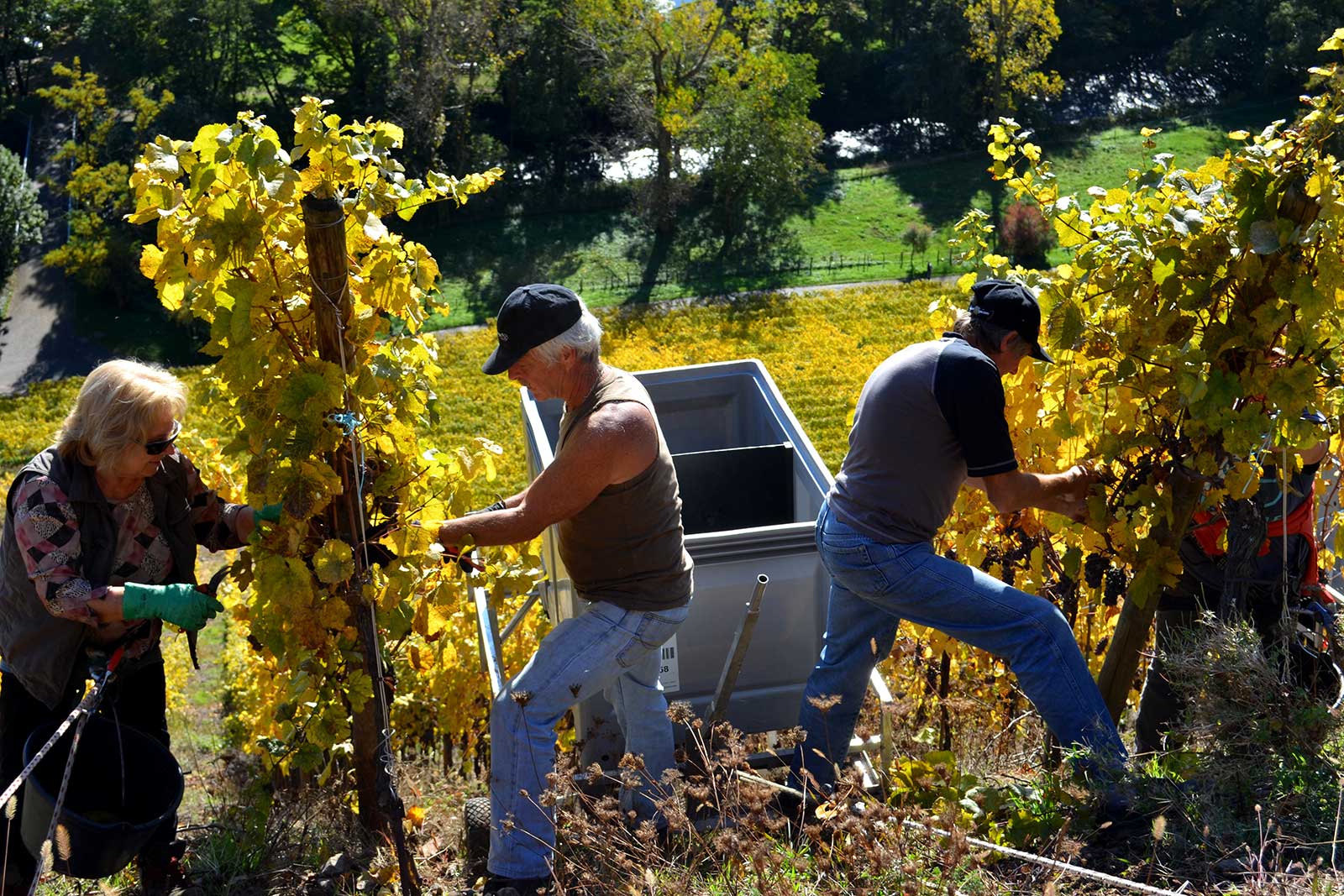
Complicating the conversion was the fact that, at least in the 1990s, there were no fabricated plowing systems for such a job. Humbrecht began to look high and low across Alsace for equipment that he could repurposed for manual plowing on a severe pitch. Much of his search was fruitless. At one garage, the owner refused the request, but an eaves-dropping old-timer interrupted them. “He said, ‘I used to work here 50 years ago. You still have some plows for this in the attic that you have never sold.’”
Sure enough, wrapped in oiled newspaper to prevent rust, were two “brand-new” plows from the early 20th century.
But once at the vineyard, another issue presented itself. Following modern viticultural trends, the vine rows had long been trained horizontally across the slope. Workers applying herbicides could better navigate the hill walking across the slope, but pulling a plow — either by winch or behind a horse — was dangerously unstable.
The solution was to pull up all of the posts, remove the wires and train the vine rows vertically.
“When I was doing this job in 1998, another old guy, he must have been in his nineties, started to laugh and mock us for a long time,” recalls Humbrecht. “I said ‘why are you laughing so stupidly at our hard work?’ He said ‘I always said that eventually someone would put those vines back to the way they were planted.’ They had been planted down in the beginning, but with the age of herbicides, they’d pulled them up and trained it horizontally because it was easier.”
The fallout from years of herbicides was significant. According to Humbrecht, because they indiscriminately killed grasses, herbicides had resulted in significant soil compaction. While this had held much of the hill together, it obstructed nutrient linkage between the vines and the top soil. With his vine rows trained vertically, and his old-is-new-again plows attached to a winch, Humbrecht began his plowing operations in the spring of 1998. But rains in May created massive erosion.
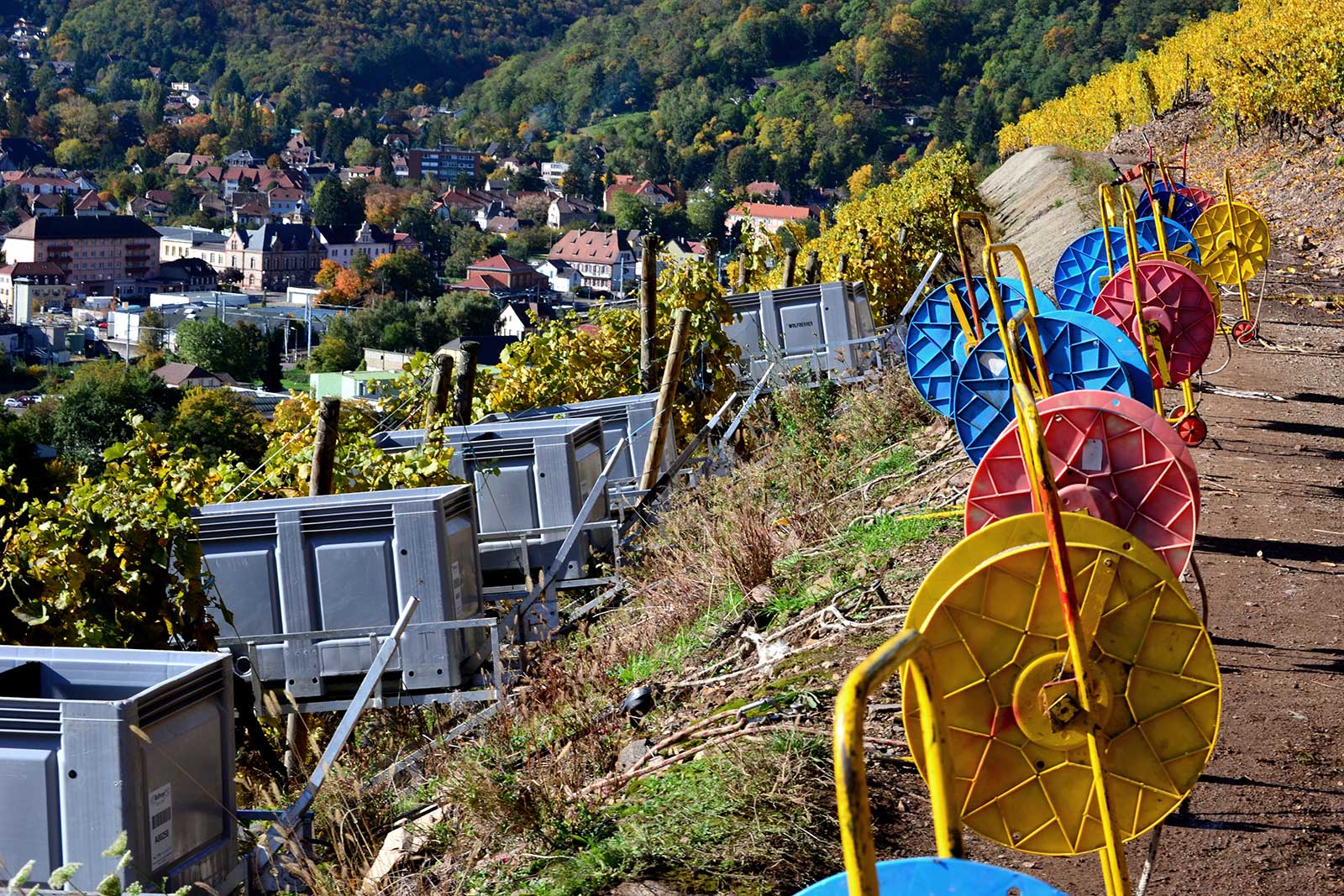
“If you create one inch of loose material on top of something very hard, and you get a good rain, everything goes down,” explained Humbrecht. After that first storm, his entire team spent a week bringing topsoil back up into the vineyard. The following Saturday, three inches of rain fell, undoing all of their work and then some. Humbrecht must have felt like Sisyphus.
“When you convert from conventional to organic viticulture on a steep slope, there is that dangerous moment,” he reminisced. “Today, I would do things differently. I would not plow too quickly. I would allow grass and weeds and wild plants to grow first, and not do anything for the first one of two years.”
This, of course, fails to solve the original issue of nutrient competition in the first few years, but to Humbrecht, the sacrifice would be worth it. Today, after years of steady rehabilitation of the soil, the Clos Saint Urbain is decompacted, absorbent of rain and oxygen, and most importantly, stable.
The Clos Saint-Théobald
To the east of the Clos Saint Urbain, the Rangen hillside angles away from the river and faces fully to the south. This pitch is known as the Clos Saint-Théobald, and, like the Clos Saint Urbain, it is a monopole belonging to one family — Domaine Schoffit.
Like the Humbrecht family, Bernard Schoffit felt the irresistible pull of the Rangen from afar. The problem was convincing his father it was worth the toil.
Named after the parish church of Thann below, the Clos Saint-Théobald had once been farmed by Franciscan monks, who erected and maintained an elaborate terracing system to reduce erosion on this portion of the hillside. After World War II, the Clos Saint-Théobald (again, not a true walled vineyard, but a vineyard with walls) came into the ownership of a weinstube in Thann. For decades, the wines were served out of the pub and — as Olivier Humbrecht recalled — were rustic to say the least.
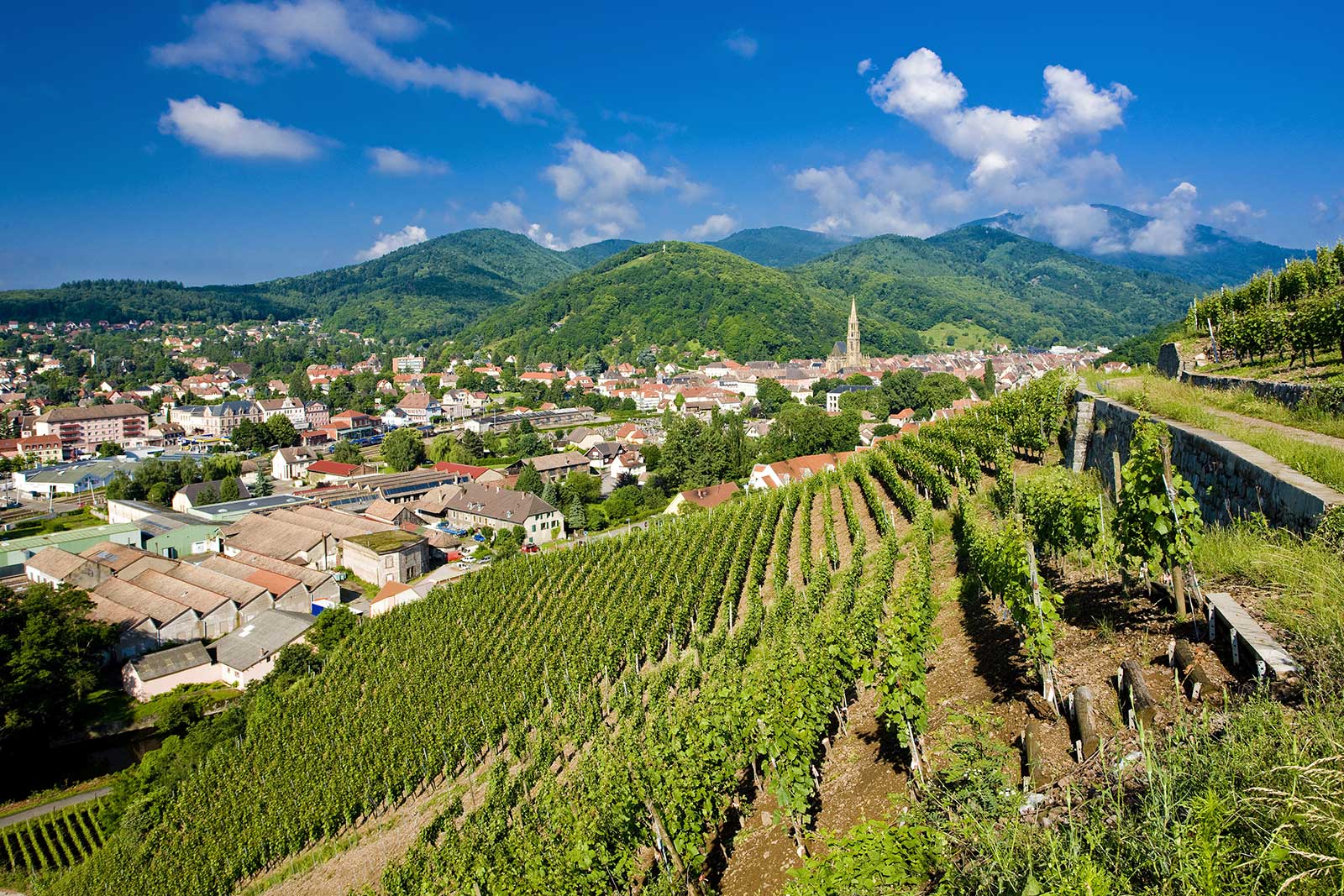
Spurred on by the sudden success of Domaine Zind-Humbrecht’s Rangen wines in the early 1980s, Bernard Schoffit began to explore buying the Clos Saint-Théobald. But unlike Léonard and Olivier Humbrecht, there wasn’t immediate consensus within the family. “Robert tried to convince Bernard that the acquisition was a bad move,” Valerie Bilgri, a representative from Schoffit’s importer, Weygandt Metzler, told me. “But it has turned out to be one of the most defining sites for the domaine.”
Less steeply pitched than the Clos Saint Urbain — but nonetheless overgrown and in terrible shape at the time — the Clos Saint-Théobald required ample work from the family and its crew when they finally bought it in 1986. The stone terraces that dated back to the Middle Ages required special attention, as they practically hold the hillside in place. Stone by stone, Bernard rebuilt them, and those monastic walls continue to provide a framework for the family’s horizontally trained vines, which are unique to the Rangen.
Brooklyn-based wine retailer Matt Rossiter — who works closely with Weygandt-Metzler and who recently toured the Clos Saint-Théobald with Bernard Schoffit and his son Alexandre — called the Rangen imposing. “Arriving in Thann, it rises like a wall on the edge of the town,” he wrote, adding that it seems to loom in the distance from every street in town. “The vineyards [of Clos Saint-Théobald] themselves are aggressively steep. The footing is treacherous as loose rocks — both small and large — and dry, sandy soils slide constantly, threatening to send you tumbling down the hillside.”
He added: “The Schoffits will instruct you: if you fall, just don’t damage the grapes.”
The subtleties between the two clos vineyards are slight but important. Because Clos Saint-Théobald faces directly south, it is a bit warmer, which allows the wines consistently to reach the sweet-wine territory ideal for Vendange Tardive or Sélection de Grains Nobles. Furthermore, the Thur River’s slight bend away from the slope means that the effects of noble rot are even more confined to the lower slopes.
Sugar and Climate Change
But the struggle to maintain balance in the wines as the climate changes and warms with each year, is real. “It is increasingly a challenge to choose a harvest date that can still produce a dry wine,” notes Rossiter. “And the grapes must be carefully selected to avoid overripeness and overblown wines.”
“Some years, the vineyard and the climate will dictate the style of wine that we need to produce, and you cannot go against it.”
Olivier Umbrecht MW
Humbrecht noted much the same. “Some years, the vineyard and the climate will dictate the style of wine that we need to produce, and you cannot go against it.” The Clos Saint Urbain Pinot Gris I tasted for this article (below) was from 2010, a year in which Humbrecht had no choice but to work with grapes affected by noble rot. In 2004, he had the opposite situation: the wine had to be dry. Other years, such as 2019, the conditions present options.
This of course imposes a challenge to creating a consistent product year after year, but for Humbrecht, that’s part of the Rangen’s charms. “We said in 2008 ‘no more sweet wines,’” notes Humbrecht. “But in the Rangen, the botrytis takes no prisoners.”
Despite the desire to present what nature provides, winemakers are increasingly pressured by the market to make their wines dry. It is a welcome development, said Ian d’Agata, but one that comes with challenges. “Sugar levels have been scaled back in the last ten years, but it’s not as simple as dialing back sugar by allowing the fermentation to go on longer.”
The Rangen, he noted, demands winemaking of the highest order of skill, otherwise, the resulting wines could easily lose their freshness and balance in a sea of sugar or “top-heavy alcohol.” With climate change shuffling the deck each year, that challenge will only get bigger.
Humbrecht knows the stakes all too well. When I asked him how he is able to sell his wines when they have the potential to be so vastly different every year, he simply laughed. “If you were to tell me you had 6,000 people who wanted to drink a Pinot Gris at 50 grams of sugar, I’d say ‘fine, I can do that.’ But these people don’t exist any more.”
The Wines of Rangen de Thann
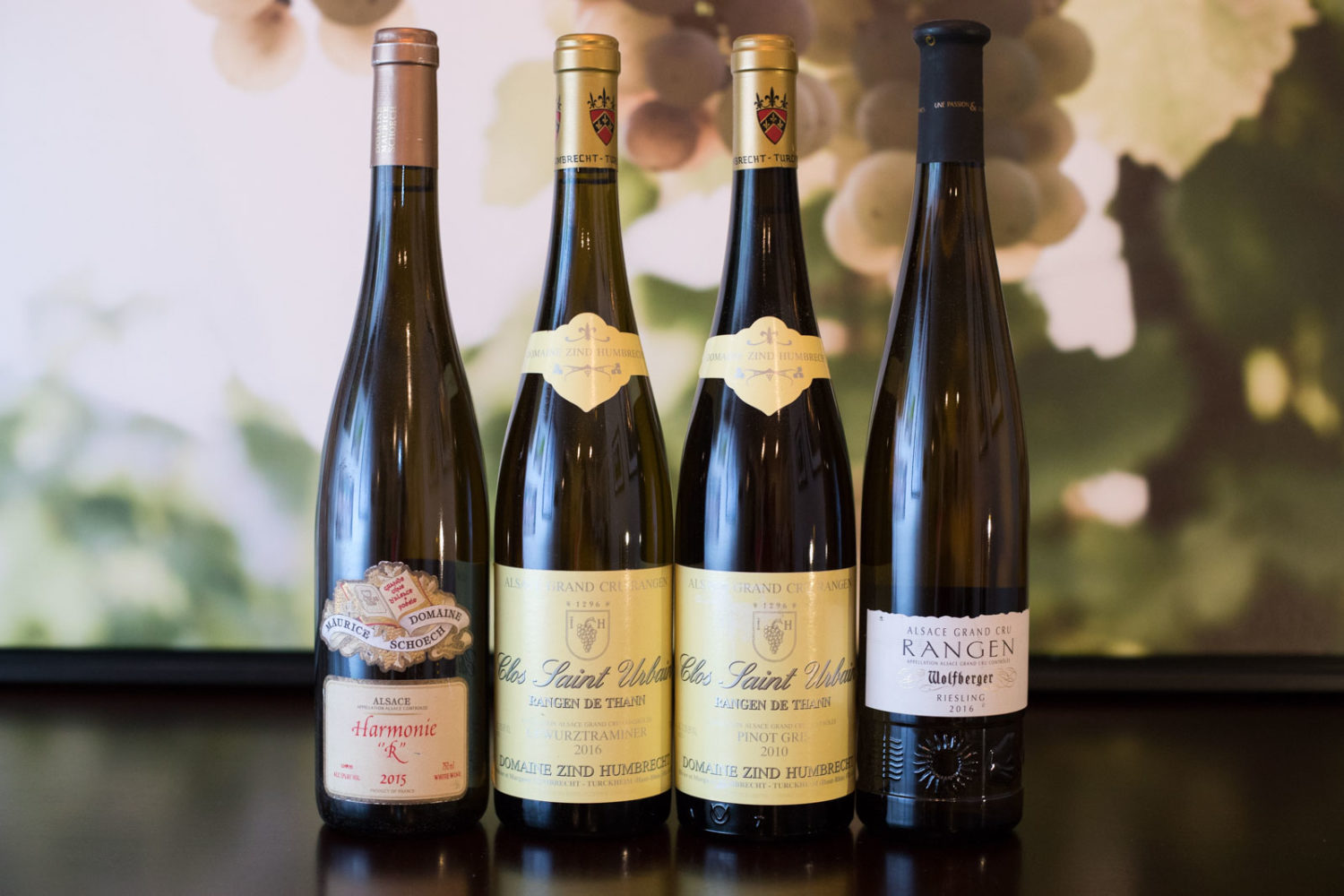
When I conceived of this article four months ago, six wines seemed like an ample cross-section, but now it feels insignificant in understanding the magic of this place. Perhaps I would have been better off with a vertical of two comparitive wines, such as a few vintages of Domaine Zind-Humbrecht’s Clos Saint Urbain Pinot Gris side-by-side to Domaine Schoffit’s Clos Saint-Théobald Pinot Gris. But the resources to pull off such a tasting weren’t available at this time.
Throughout, I was impressed by these wines from the Rangen, although not a single one captured the full story of the place. In hindsight, that is too tall of an order.
The most esteemed wine — Domaine Zind-Humbrecht’s Clos Saint Urbian Pinot Gris — was majestic and finely detailed, but rich and heavy. While the Rangen’s signature smokiness was there, I felt like it was a bit suppressed.
Surprisingly, it was the two Gewurztraminer that impressed me the most (me? A fan of Gewurztraminer?), but I walked away from these six wines feeling as though I’d read six isolated pages of a novel — there were a lot of gaps to fill. I need to keep reading.
This is because the Rangen displays such incredible variability from year to year, especially with the wines of Domaine Zind-Humbrecht’s Clos Saint Urbain, which face the river. One year could be perfectly dry; the next could be sweet with a thick vein of botrytis flavor through its core.
One way to know what a particular bottle will offer is to look for the “Indice” number on the label, an index devised in Alsace to identify sweetness on a scale of 1 to 5 (with 5 being sweetest). The problem is that the system has not been adopted by all vignerons, as it is voluntary, and therefore some producers label wines off-dry that are actually sweet.
Better yet, consult the domaine’s website. Domaine Zind-Humbrecht’s wines are methodically catalogued by vintage with meticulous notes on each year’s weather patterns and the technical data of each wine, all of it online. (You would expect nothing less from the first Master of Wine in France).
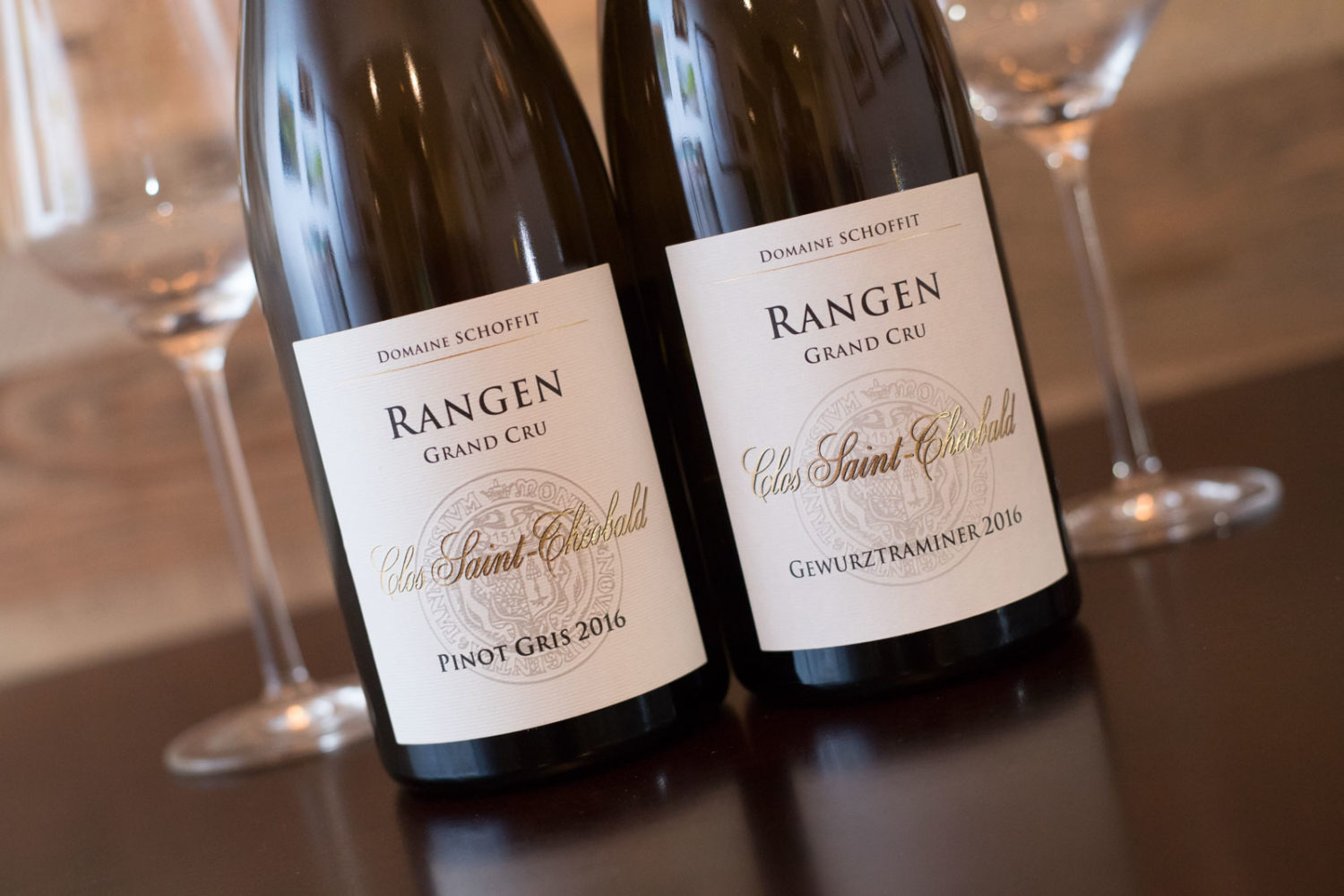
2010 Domaine Zind-Humbrecht Clos Saint Urbain Alsace Grand Cru Rangen de Thann Pinot Gris
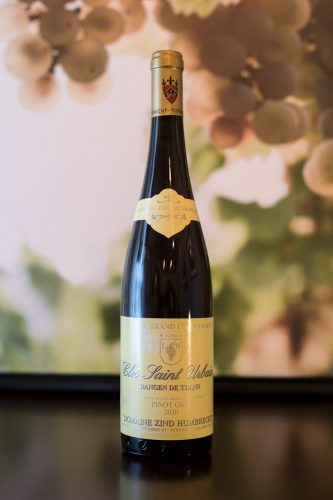 Grand Cru Rangen de Thann (Alsace AOC)
Grand Cru Rangen de Thann (Alsace AOC)
Grapes: Pinot Gris (100%)
Alcohol: 13.5%
Rating: ★★★★★ (out of five)
Food friendliness: Selective
Value: As expected
Learn more about our wine icons.
Tasting notes: The 2010 vintage of Zind-Humbrecht’s signature wine saw a tiny crop, and foggy mornings nearly every day in October. “It was nearly impossible to avoid noble rot,” Humbrecht told me, adding that it was one of the richest vintages in all their years working with the Rangen de Thann. At 49g/L of residual sugar, the 2010 Pinot Gris is massively sweet.
Aromas suggest juicy apricots, orange peel, light rose, lemon verbena and an ever-so-faint bit of flint, although I would note the aromatics are predominantly of fruit and flowers. The palate however, shows the mastery of Zind-Humbrecht’s approach. It really threads the needle, as normally wines this sweet can be fatiguing and garish. There is a light crispness on the mid-palate that is balanced by the wine’s density and heft. And as it opens over time, leathery tones of tanned hide emerge both on the nose and on the palate. This feature alone is something I’ve never encountered in a white wine before. A mystifying but thoroughly enjoyable puzzle of a wine.
2016 Domaine Zind-Humbrecht Clos Saint Urbain Alsace Grand Cru Rangen de Thann Gewurztraminer
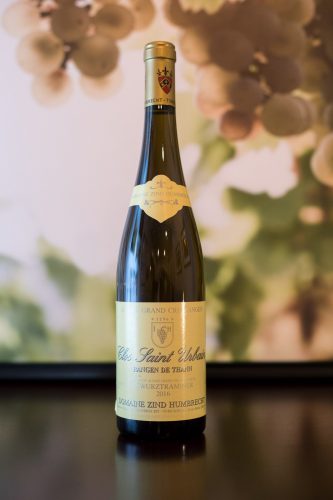 Grand Cru Rangen de Thann (Alsace AOC)
Grand Cru Rangen de Thann (Alsace AOC)
Grapes: Gewurztraminer (100%)
Alcohol: 15%
Rating: ★★★★★ (out of five)
Food friendliness: Selective
Value: A little pricey
Tasting notes: My favorite wine from this session on the Grand Cru Rangen de Thann actually comes from one of my least favorite grapes. Normally, Gewurztraminer and my palate are like two pundits shouting at each other on television. Then again, I’ve never had Gewurztraminer like this.
With its golden color and massive aromatics, the Zind-Humbrecht Gewurztraminer from Clos Saint Urbain makes an immediate entrance after the cork has been removed. It’s tones reminded me of wild roses by the sea (specific? Yes, but my memory was transported to Cape Cod’s dunes in June). There was also lychee and flint. A second impression of the aromas revealed even more of that smoky, volcanic sulphur note that has made the Rangen de Thann so famous. Here it was, and I couldn’t turn away. The nose suggests a vendage tardive, but the wine is completely dry (note: in most years, the Gewurztraminer has more sweetness). The lean body, crisp acidity, punchy alcohol and rich flavors all wove together brilliantly, with a featherweight finish. “No stray threads,” I wrote in my notes. One of Alsace’s best wines, and perhaps the best Gewurztraminer in the world.
2016 Domaine Schoffit Clos Saint-Théobald Alsace Grand Cru Rangen de Thann Gewurztraminer
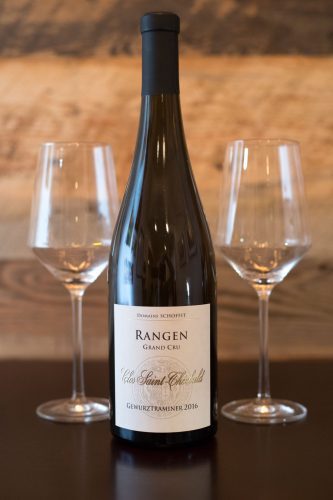 Grand Cru Rangen de Thann (Alsace AOC)
Grand Cru Rangen de Thann (Alsace AOC)
Grapes: Gewurztraminer (100%)
Alcohol: 13%
Rating: ★★★★★ (out of five)
Food friendliness: Selective
Value: As expected
Tasting notes: Domaine Schoffit’s Gewurztraminer from the Clos Saint-Théobald is a perfect counterpoint to Domaine Zind-Humbrecht’s from the Clos Saint Urbain. Like Zind-Humbrecht’s version, it is pure delight with little fatigue — a Gewurztraminer that even I can love. Where it differs is in power, depth and smokiness. Schoffit’s rendition seems more delicate, more floral and spicier. On the palate, the tones are measured and restrained, which likely accounts for the lack of fatigue from this wine. There was a touch of sweetness to hold the wine together and to polish the variety’s harsher edges, but enough acidity and even a touch of tannin to give the wine grip.
I found myself missing Alsace and its landscape, people and cuisine while drinking this wine, which — come to think of it — is one of the highest compliments you can give wine.
2016 Wolfberger Alsace Grand Cru Rangen de Thann Riesling
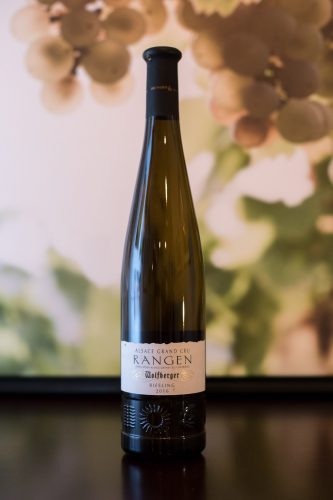 Grand Cru Rangen de Thann (Alsace AOC)
Grand Cru Rangen de Thann (Alsace AOC)
Grapes: Riesling (100%)
Alcohol: 12.5%
Rating: ★★★★ 3/4 (out of five)
Food friendliness: Impeccable
Value: Very Good
Tasting notes: The lone Riesling tasted in this round comes from Wolfberger, the third-largest land owner in the Rangen. Their Riesling plot is concentrated in the upper corner, snug against the Clos Saint-Théobald and far enough away from the Thur River’s kiss.
This Riesling is light in color and on the palate, reminiscent of the many Rieslings in Germany that come from volcanic origin, such as the Ürziger Wurzgarten. Aromas are strongly suggestive of lime peel, tart peach and sour apple, delicately touched by honeysuckle-like floral tones. At the start of each sip, the fruit-and-flowers reign supreme, but I quickly found an electricity to the wine’s acidity that seemed more urgent and pressing than I have found elsewhere with Alsace’s Riesling. A very good wine.
2015 Domaine Maurice Schoech Harmonie “R” Alsace
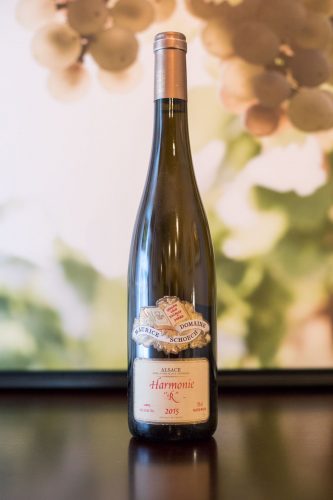 (Alsace AOC)
(Alsace AOC)
Grapes: Pinot Gris (70%), Riesling (28%), Gewurztraminer (2%)
Alcohol: 13%
Rating: ★★★★ 3/4 (out of five)
Food friendliness: Impeccable
Value: As expected
Tasting notes: A very rare wine, as less than 1,000 bottles are produced each year, the Harmonie “R” is the Grand Cru Rangen de Thann’s only field blend, sourcing a mix of mostly Pinot Gris, with Riesling and Gewurztraminer from the highest plot, above the Clos Saint Urbain. However, due to the wine laws of Alsace, it cannot claim the vineyard on the label because Grand Cru wines can only be varietal.
Field blends are often touted by their winemakers as the true representation of a vineyard’s terroir, but I’m not so sure in this case. While the wine is brilliantly balanced and delicious — with a sensation of phantom sweetness from the fruit, despite being vinified dry — I couldn’t help but notice its component parts in the aromas and taste. The Gewurztraminer, despite accounting for only 2% of the wine, is pronounced on the nose, lending a honeyed-rose tone. Riesling seems to account for the wine’s volume and structure, while the Pinot Gris balances it all with an acidity akin to a crisp, underripe pear. These components do “harmonize” to borrow the Schoech family’s moniker for it, but whether this is what the Grand Cru Rangen de Thann tastes like remains to be seen. There is just so much more to this one vineyard than can be captured by the ambition of a single bottle.
Note: Parts of these interviews were edited for clarity. Wines were provided for this article by Wines of Alsace and Weygandt-Meltzler Importing based upon a story pitch from the editor.
Learn more about our editorial policy.

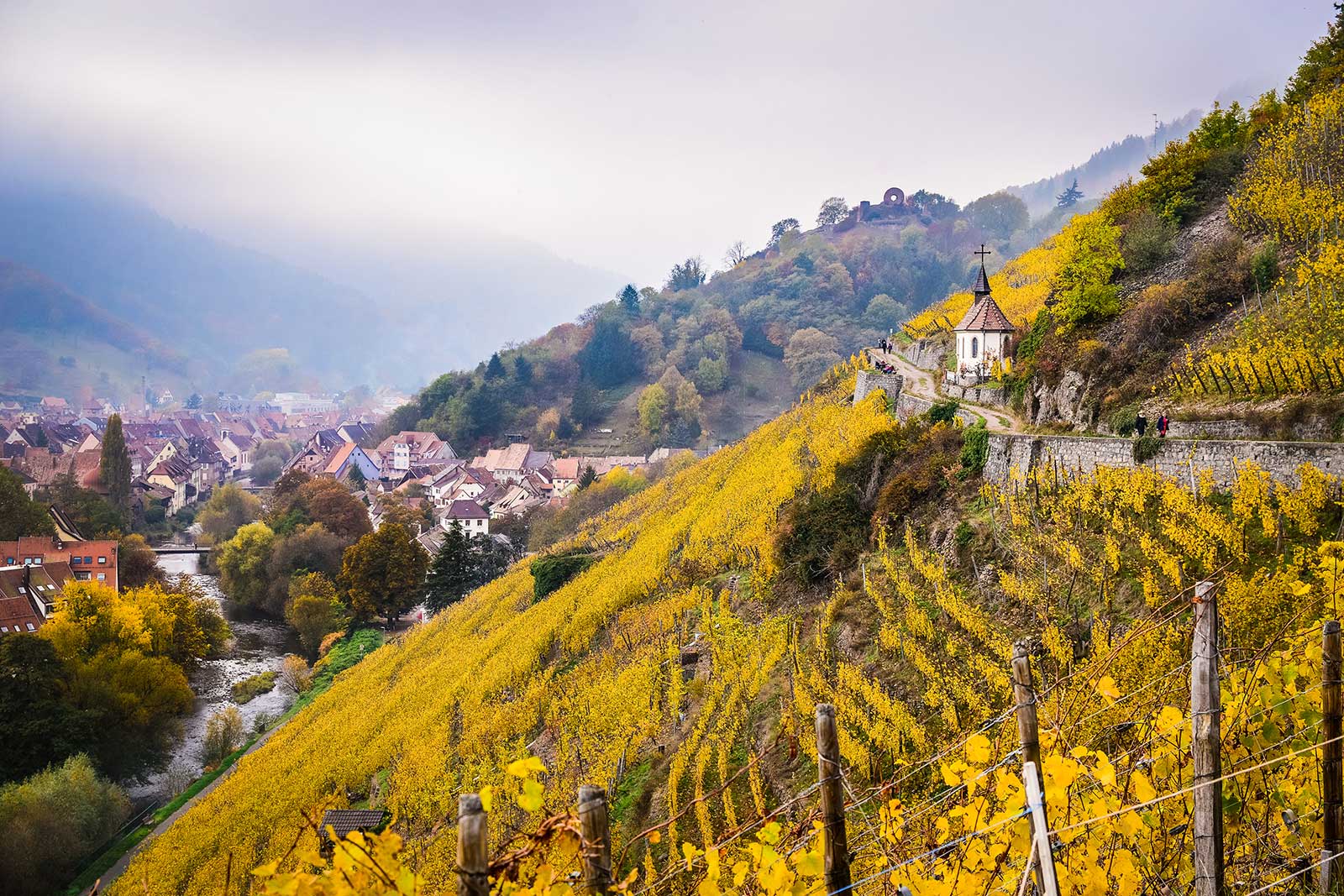
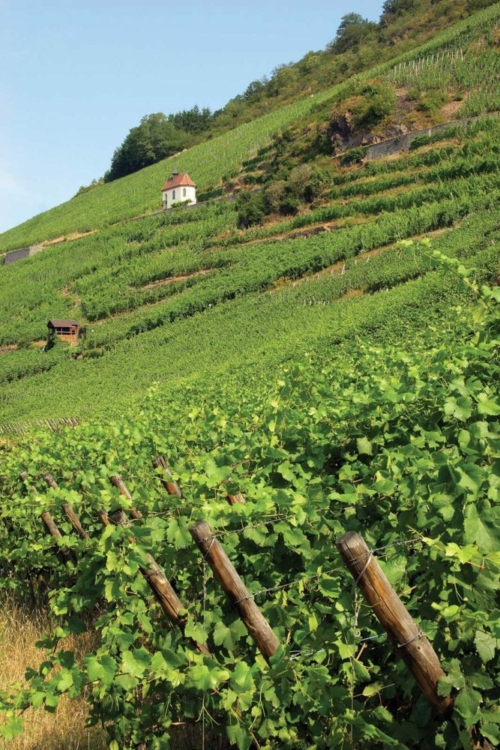
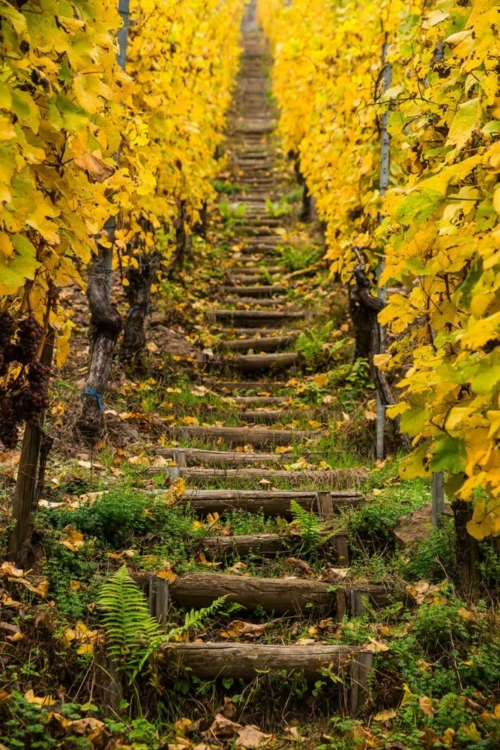
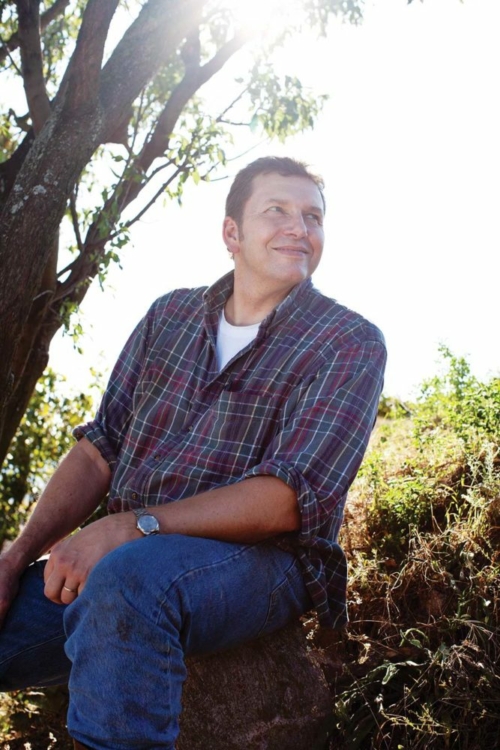
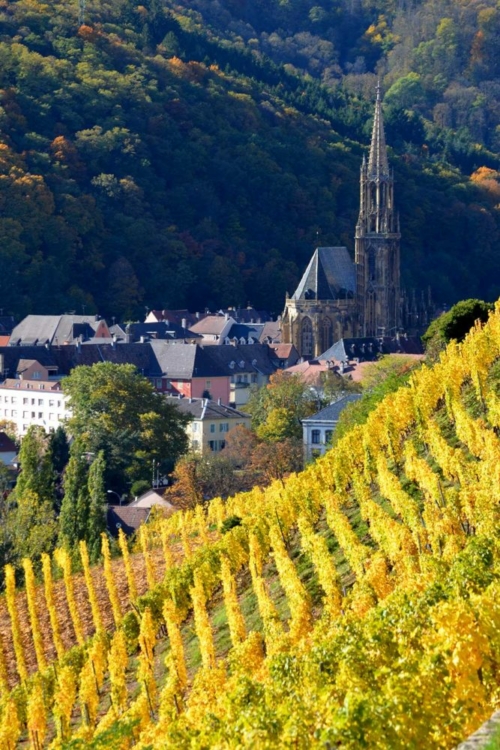
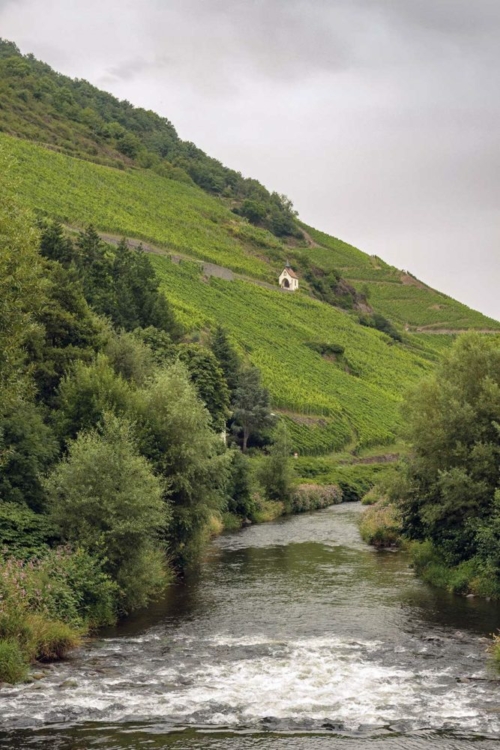
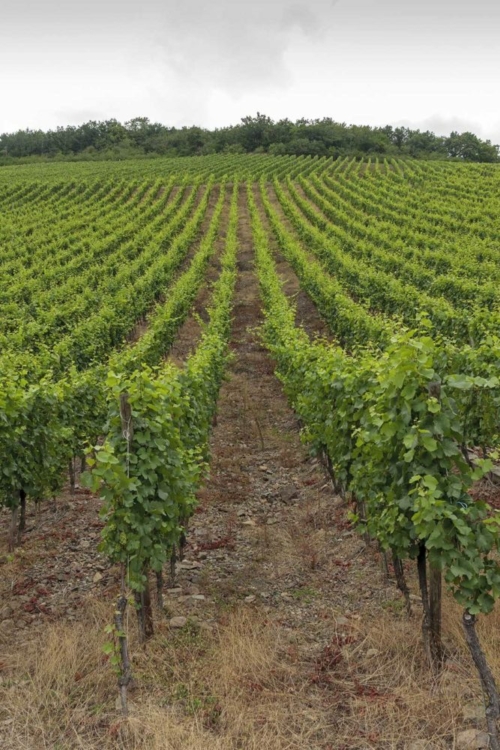
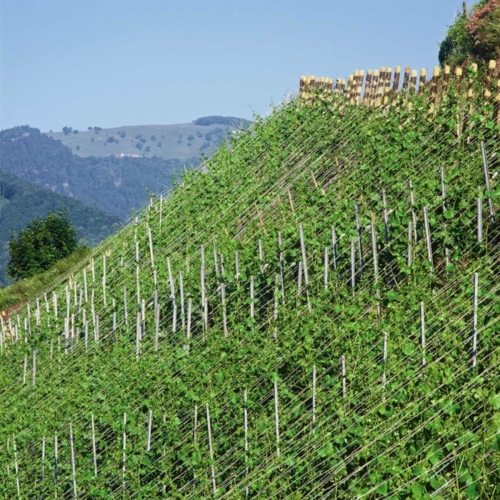
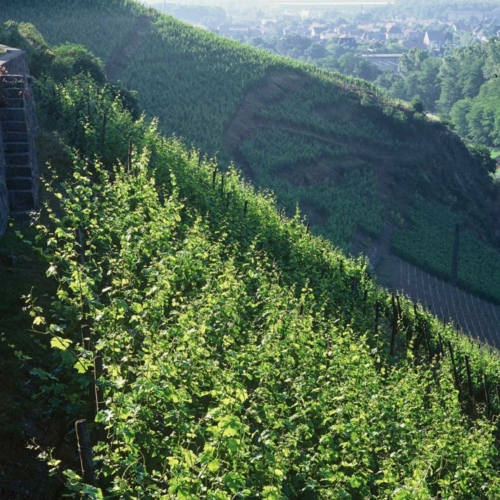
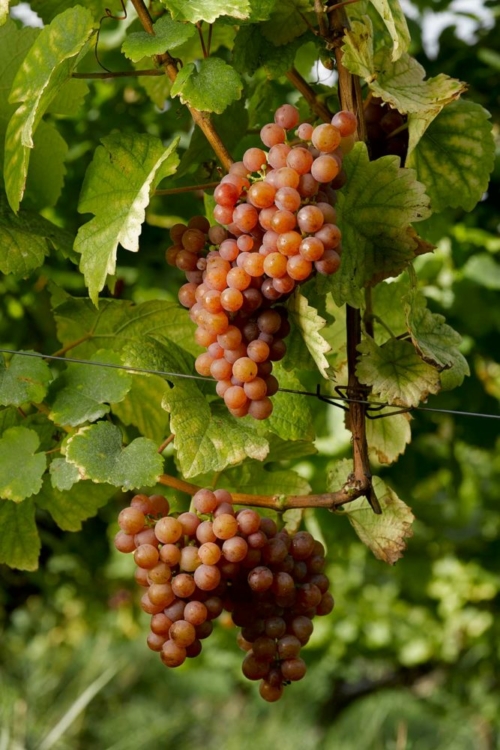
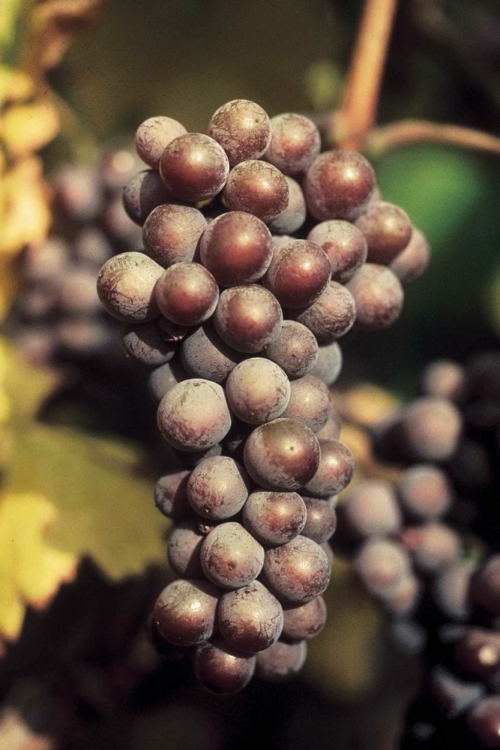
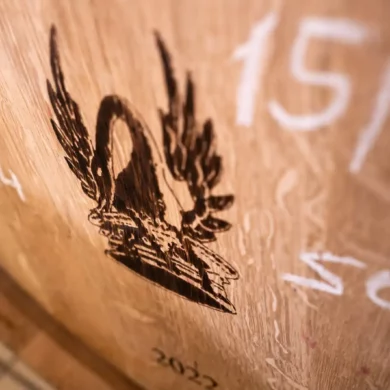
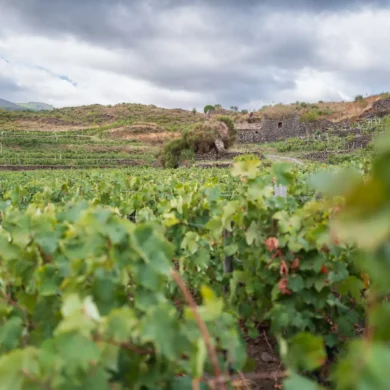
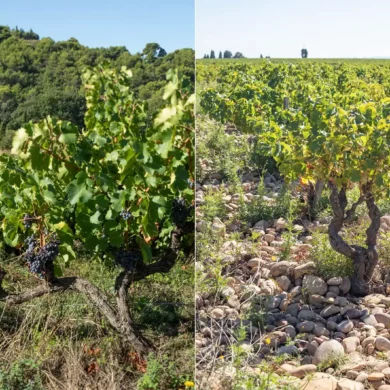
3 Comments